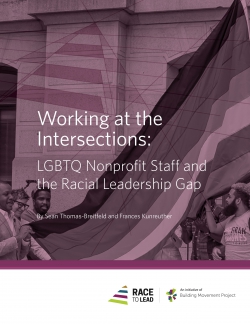Jul
10
2017
Systemic racial bias, compounded by anti-LGBTQ bias, prevents qualified LGBTQ staff of color from ascending to leadership positions in the nonprofit sector

Written by Sean Thomas-Breitfeld
Today, the Building Movement Project released a new report, Working at the Intersections: LGBTQ Nonprofit Staff and the Racial Leadership Gap, analyzing the experiences of people who identify as Lesbian, Gay, Bisexual, Transgender, or Queer (LGBTQ) working in the nonprofit sector. The report builds on data from BMP’s Nonprofits, Leadership, and Race Survey, conducted with more than 4,000 respondents across the nonprofit sector, 20% of whom identified as LGBTQ. This LGBTQ-focused report follows the recent release of Race to Lead: Confronting the Nonprofit Racial Leadership Gap, a report also based on this survey.
BMP’s research shows that LGBTQ people of color in the nonprofit sector face increased challenges to career advancement compared to their straight and white LGBTQ counterparts. It also provides insights into how institutionalized racial bias within nonprofits and the nation’s patchwork of anti-discrimination laws uniquely affect their professional trajectories. A solutions-driven endeavor, the report offers concrete recommendations for the nonprofit sector to address these barriers.
Some key findings include:
- Race was identified as the primary barrier to the career advancement of LGBTQ people of color. Among survey respondents who identified as LGBTQ people of color, twice as many reported that their race had a negative impact on their careers, compared to their sexual orientation.
- Geography affects LGBTQ people’s ability to thrive in their work environments. Many write-in responses reflect the difficulties LGBTQ people face when working in more conservative parts of the country.
- There are virtually no differences in background between LGBTQ staff of color and their white counterparts. LGBTQ people of color have similar backgrounds and qualifications in terms of their education, salaries, current roles, or years in the sector. LGBTQ people of color were also more likely to aspire to lead a nonprofit.
Some solutions for nonprofits that BMP recommends include:
- Address racism through a multi-faceted and intersectional lens. A primary focus on race – through sector-wide campaigns or organizational change initiatives – can also lay needed groundwork for nonprofits to begin addressing issues of anti-LGBTQ bias that also exist in the sector.
- Take a stand against discrimination, even in the face of regional political barriers. Funders and nonprofit networks/associations should also push organizations to adopt nondiscrimination policies that include sexuality and gender identity, and establish systems for monitoring and addressing discrimination.
- Foundations must demonstrate that intersectional concerns are priorities. Funders supporting the LGBTQ movement should both increase funding to organizations led by LGBTQ people of color, and support more mainstream groups in the LGBTQ movement take steps to become better workplaces for diverse members of the LGBTQ community.
** To download the full report, please visit: http://racetolead.org/lgbtq.html
